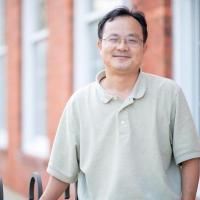How Genes Modulate Patterns of Aging-Related Changes on the Way to 100: Biodemographic Models and Methods in Genetic Analyses of Longitudinal Data.
Date
2016
Journal Title
Journal ISSN
Volume Title
Repository Usage Stats
views
downloads
Citation Stats
Attention Stats
Abstract
BACKGROUND AND OBJECTIVE: To clarify mechanisms of genetic regulation of human aging and longevity traits, a number of genome-wide association studies (GWAS) of these traits have been performed. However, the results of these analyses did not meet expectations of the researchers. Most detected genetic associations have not reached a genome-wide level of statistical significance, and suffered from the lack of replication in the studies of independent populations. The reasons for slow progress in this research area include low efficiency of statistical methods used in data analyses, genetic heterogeneity of aging and longevity related traits, possibility of pleiotropic (e.g., age dependent) effects of genetic variants on such traits, underestimation of the effects of (i) mortality selection in genetically heterogeneous cohorts, (ii) external factors and differences in genetic backgrounds of individuals in the populations under study, the weakness of conceptual biological framework that does not fully account for above mentioned factors. One more limitation of conducted studies is that they did not fully realize the potential of longitudinal data that allow for evaluating how genetic influences on life span are mediated by physiological variables and other biomarkers during the life course. The objective of this paper is to address these issues. DATA AND METHODS: We performed GWAS of human life span using different subsets of data from the original Framingham Heart Study cohort corresponding to different quality control (QC) procedures and used one subset of selected genetic variants for further analyses. We used simulation study to show that approach to combining data improves the quality of GWAS. We used FHS longitudinal data to compare average age trajectories of physiological variables in carriers and non-carriers of selected genetic variants. We used stochastic process model of human mortality and aging to investigate genetic influence on hidden biomarkers of aging and on dynamic interaction between aging and longevity. We investigated properties of genes related to selected variants and their roles in signaling and metabolic pathways. RESULTS: We showed that the use of different QC procedures results in different sets of genetic variants associated with life span. We selected 24 genetic variants negatively associated with life span. We showed that the joint analyses of genetic data at the time of bio-specimen collection and follow up data substantially improved significance of associations of selected 24 SNPs with life span. We also showed that aging related changes in physiological variables and in hidden biomarkers of aging differ for the groups of carriers and non-carriers of selected variants. CONCLUSIONS: . The results of these analyses demonstrated benefits of using biodemographic models and methods in genetic association studies of these traits. Our findings showed that the absence of a large number of genetic variants with deleterious effects may make substantial contribution to exceptional longevity. These effects are dynamically mediated by a number of physiological variables and hidden biomarkers of aging. The results of these research demonstrated benefits of using integrative statistical models of mortality risks in genetic studies of human aging and longevity.
Type
Department
Description
Provenance
Subjects
Citation
Permalink
Published Version (Please cite this version)
Publication Info
Yashin, Anatoliy I, Konstantin G Arbeev, Deqing Wu, Liubov Arbeeva, Alexander Kulminski, Irina Kulminskaya, Igor Akushevich, Svetlana V Ukraintseva, et al. (2016). How Genes Modulate Patterns of Aging-Related Changes on the Way to 100: Biodemographic Models and Methods in Genetic Analyses of Longitudinal Data. N Am Actuar J, 20(3). pp. 201–232. 10.1080/10920277.2016.1178588 Retrieved from https://hdl.handle.net/10161/14755.
This is constructed from limited available data and may be imprecise. To cite this article, please review & use the official citation provided by the journal.
Collections
Scholars@Duke

Anatoli I. Yashin

Konstantin Arbeev
Konstantin G. Arbeev received the M.S. degree in Applied Mathematics from Moscow State University (branch in Ulyanovsk, Russia) in 1995 and the Ph.D. degree in Mathematics and Physics (specialization in Theoretical Foundations of Mathematical Modeling, Numerical Methods and Programming) from Ulyanovsk State University (Russia) in 1999. He was a post-doctoral fellow in Max Planck Institute for Demographic Research in Rostock (Germany) before moving to Duke University in 2004 to work as a Research Scientist and a Senior Research Scientist in the Department of Sociology and the Social Science Research Institute (SSRI). He is currently an Associate Research Professor in SSRI. Dr. Arbeev's major research interests are related to three interconnected fields of biodemography, biostatistics and genetic epidemiology as pertains to research on aging. The focus of his research is on discovering genetic and non-genetic factors that can affect the process of aging and determine longevity and healthy lifespan. He is interested in both methodological advances in this research area as well as their practical applications to analyses of large-scale longitudinal studies with phenotypic, genetic and, recently, genomic information. Dr. Arbeev authored and co-authored more than 150 peer-reviewed publications in these areas.

Dequing Wu

Alexander Kulminski

Irina Kulminskaya

Igor Akushevich

Svetlana Ukraintseva
Dr. Ukraintseva studies causes of human aging and related decline in resilience, to identify genetic and other factors responsible for the increase in mortality risk with age eventually limiting longevity. She explores complex relationships, including trade-offs, between physiological aging-changes and risks of major diseases (with emphasis on Alzheimer’s and cancer), as well as survival, to find new genetic and other targets for anti-aging interventions and disease prevention. She also investigates possibilities of repurposing of existing vaccines and treatments for AD prevention and interventions into the aging. For this, Dr. Ukraintseva and her team use data from several large human studies containing rich genetic and phenotypic information (including longitudinal measurements) on thousands of individuals. Dr. Ukraintseva is a PI and Key Investigator on several NIH funded grants, and has more than 130 peer-reviewed publications, including in major journals such as Nature Reviews, Stroke, European Journal of Human Genetics, and some other.
Unless otherwise indicated, scholarly articles published by Duke faculty members are made available here with a CC-BY-NC (Creative Commons Attribution Non-Commercial) license, as enabled by the Duke Open Access Policy. If you wish to use the materials in ways not already permitted under CC-BY-NC, please consult the copyright owner. Other materials are made available here through the author’s grant of a non-exclusive license to make their work openly accessible.
